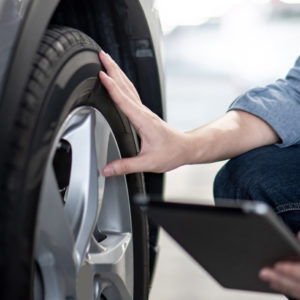A tire pressure monitoring system (TPMS) relearn is a process that lets your vehicle recognize and connect to its tire pressure sensors. It’s typically done after new sensors are installed, but more commonly, after the tires are rotated, else your panel may display low pressure on the wrong tire.
The TPMS first identifies the tire pressure sensors, then their IDs are reprogrammed in the system to match their current positions. After that, the TPMS ensures all the sensors are communicating with it properly.
But what exactly makes TPMS relearn so important and how does one go about doing it?
Well, to cover every vehicle would require a very thick book (not kidding here), but we’ll touch on some of the basics. Your vehicle will have specific procedures that may differ tremendously from what you see here.
Note: Under the TREAD Act (Transportation Recall Enhancement, Accountability, and Documentation Act), which was signed into law in 2000, Tire Pressure Monitoring Systems (TPMS) became mandatory in the United States for all new passenger vehicles manufactured on or after September 1, 2007.
What Makes TPMS Relearn Important?

Relearning your TPMS sensors ensures the system can accurately recognize the correct sensor IDs. This is crucial, especially after rotating the tires or replacing the sensors.
Enhances Vehicle Performance
Letting your vehicle relearn the sensors helps keep your vehicle’s tire pressure optimal. With accurate monitoring, you can identify and address overinflated and underinflated tires. That means the engine won’t need to work harder to compensate, giving way to enhanced performance and fuel efficiency.
Improves Safety and Handling
Having a TPMS that works will help you keep your vehicle’s tire pressure within optimal levels. Proper tire inflation not only improves your ride’s performance but also gives you more traction, resulting in a safer and smoother driving experience.
Prevents False Flags
If your TPMS system simply turns on a light rather than reports pressure on your dash display, there will typically be no learning necessary, except in some cases when a sensor is replaced. But tire rotation on a light-only system won’t require relearning.
This is the most common issue after tire rotations is the sensor display not matching the actual sensors. Without relearning after rotation, the system has no way of knowing which tire is where on most systems.
This may not become apparent until you notice that, for example, your right front tire has low pressure. When you add air to the right front tire, you notice that the pressure on the display is changing on the left rear tire.
What Happens if You Don’t Relearn the TPMS Sensors?
If you don’t let your vehicle relearn the sensors, they simply won’t work. You can still drive even without properly functioning TPMS sensors, though doing so comes with some disadvantages.
For example, you’ll have a harder time determining whether your vehicle’s tires have enough air in them. Underinflated tires mean less control over your vehicle, meaning you’re more likely to get into an accident without a working TPMS.
Not all vehicles can automatically relearn the TPMS while driving. Because of this, it’s a good practice to relearn the TPMS as soon as you’re able to.
TMPS Sensor Relearn Methods
There are three ways to relearn your vehicle’s TPMS sensors: manual relearning, OBD relearning, and auto relearning.
Manual Relearning
To manually relearn the TPMS, you need to conduct a series of ignition sequences and pedal presses. The exact method varies depending on your car’s make and model. You can check your vehicle owner’s manual for specific instructions.
Manual relearning is widely used because it doesn’t require fancy tools and technology. You can relearn your TPMS without buying any special equipment.

OBD Relearning
If manual relearning requires you to turn keys and press pedals, you can conduct OBD relearning using electronic devices, specifically a TPMS relearn tool. Here is a minute and twenty second video of the procedure on a 2009 Chevy.
Simply connect the tool to the on-board diagnostics (OBD) port, and it’ll help the sensors relearn the sensor IDs to their respective tire positions. It’s a straightforward process that gives way to accurate and reliable results.
Auto Relearning
If you’d rather let your vehicle relearn the TPMS automatically, you can simply drive and let your system adjust the sensors. This method of relearning is known as auto relearning or automatic relearning.
This is sometimes necessary when your system only has a light and you’ve added tire pressure to the low tire. The light may not extinguish until you’ve driven a certain distance and speed.
Bear in mind that not all vehicles are capable of relearning the TPMS automatically. If your vehicle has this option, you can accomplish auto relearning by simply driving. The exact distance you need to travel or the time you need to spend on the road varies. When in doubt, consult your vehicle owner’s manual.
How to Use a TPMS Relearn Tool
Using a TPMS relearn tool is a simple process that will help your vehicle relearn the system without many complications. Keep in mind that the exact process of relearning the TPMS varies depending on the make and model of your vehicle and the tool itself. Good TPMS tools will have you select the make, model, year of the vehicle, etc.
What You’ll Need
- TPMS relearn tool that’s compatible with your vehicle
What to Do
- Connect your TPMS relearn tool to your vehicle’s OBD port, which is typically under the dashboard.
- Turn on your TPMS relearn tool and select the TPMS relearn option (or anything similar).
- Follow the instructions indicated on your TPMS relearn tool and complete the procedure. The exact procedure will vary depending on the make and model of your vehicle as well as the TPMS relearn tool.
- Check the TPMS light on your dashboard and confirm that there are no errors. The light should stay off.
Get Tire Pressure Monitor Sensors Easily Online
Your vehicle’s TPMS is a handy tool that you should try to maintain because it can warn you when you have low tire pressure, which is the leading cause of blowouts and excessive tire wear. Low tire pressure is incredibly unsafe, especially during the summer. Over time, a vehicle’s TPMS can become faulty. Sometimes this might just warrant reprogramming the unit. However, sometimes it needs to be replaced.
Finding a high-quality aftermarket tire pressure monitor might seem difficult. Fortunately, CarParts.com has a great selection of TPMS parts. We understand that quality is paramount when it comes to certain TPMS components. Hence, we only source parts from trusted aftermarket manufacturers. Need your part as soon as possible? Don’t worry, as we have strategically located warehouses that allow us to ship your parts in as fast as two business days.
Keep your vehicle’s tires inflated with the right air pressure. Check out our tire pressure monitoring system parts like TPMS sensors and TMPS valve stems. Order the part you need today!
Any information provided on this Website is for informational purposes only and is not intended to replace consultation with a professional mechanic. The accuracy and timeliness of the information may change from the time of publication.

































